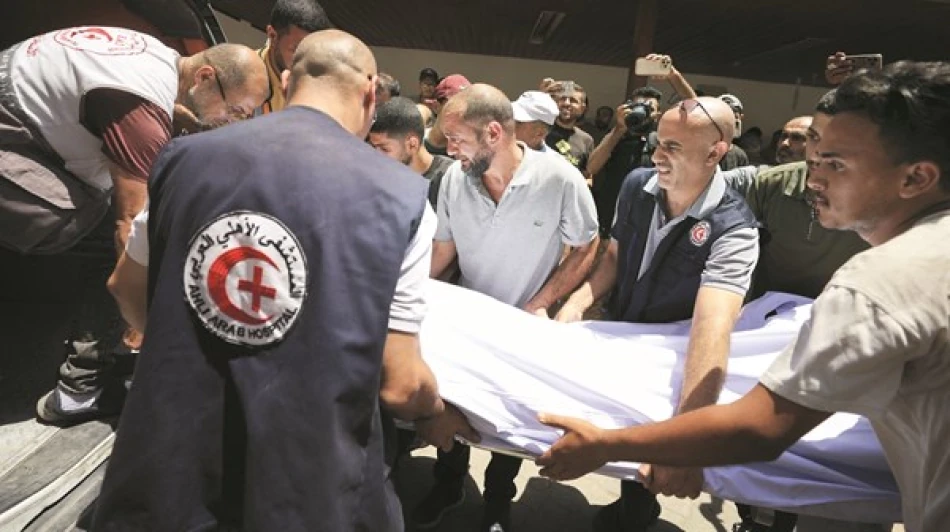
Israeli Airstrikes Target Gaza's Sole Catholic Church, Raising Concerns for Religious Minorities
Gaza Church Strike Sparks International Outrage as Ceasefire Talks Intensify
An Israeli airstrike on Gaza's only Catholic church has killed three people and wounded an Argentine priest who regularly briefed Pope Francis on the conflict, triggering sharp condemnation from the Vatican and European leaders. The attack on the Holy Family Church comes as US-backed ceasefire negotiations between Israel and Hamas appear to be gaining momentum after months of deadlock, with both sides reportedly making key concessions on troop withdrawals and prisoner exchanges.
Vatican and European Leaders Condemn Church Attack
Pope Leo XIV expressed "deep sorrow" over the strike on the Holy Family Church in Gaza, calling for an "immediate ceasefire." The attack left the church's roof damaged, its stone facade burned, and windows shattered. Father Romanelli, an Argentine priest who sustained minor injuries, had been a regular contact for the late Pope Francis regarding developments in the Israeli-Palestinian conflict.
Italian Prime Minister Giorgia Meloni condemned the strike in unusually strong terms, stating that "attacks by Israel on civilian populations for months are unacceptable. No military action can justify such behavior." French Foreign Minister Jean-Noël Barrot described the bombing as "unacceptable," noting that the church was under France's "historical protection."
Broader Pattern of Civilian Casualties
The church attack was part of a deadly day across Gaza, with Palestinian medics reporting at least 23 deaths. An airstrike in northern Jabalia killed a man, his wife, and their five children, while another northern strike killed eight men responsible for protecting aid trucks. Additional strikes in central Gaza and the eastern Zeitoun neighborhood claimed seven more lives.
Ceasefire Negotiations Show Signs of Progress
Despite the continued violence, diplomatic sources indicate that US-backed mediation efforts led by Qatar and Egypt are making headway after more than 10 days of intensive talks. The proposed 60-day truce would see the return of 10 living hostages and the remains of 18 others in exchange for the release of Palestinian prisoners held by Israel.
Key Concessions Emerge
Israeli media reports suggest Prime Minister Benjamin Netanyahu has instructed his negotiating team in Doha to show flexibility. Most significantly, Israel appears ready to abandon its demand for maintaining military presence along the so-called Morag axis in southern Gaza during the ceasefire. The country is also reportedly willing to reduce the size of the security buffer zone it would maintain near the Israeli border.
Hamas received an updated withdrawal map from mediators showing Israeli forces repositioning to a 1-kilometer depth along Gaza's northern and eastern borders. However, the group continues to demand Israel's complete withdrawal to pre-October 7 positions, according to sources familiar with the negotiations.
Humanitarian Aid Mechanism Takes Shape
Negotiators have reportedly reached agreement on humanitarian aid distribution, with the UN resuming its traditional oversight role. However, Israel maintains its requirement for comprehensive security screening of all aid trucks entering Gaza.
Egypt and Jordan are preparing to upgrade border crossings to handle larger volumes of aid shipments, following recent agreements between the European Union and Israel to increase assistance to Palestinian civilians.
Prisoner Exchange Details Under Discussion
The talks have focused heavily on what negotiators call "release keys" – determining the identities and numbers of prisoners and hostages to be freed during the proposed two-month humanitarian truce. Hamas is pushing for the release of senior movement leaders held in Israeli prisons, as well as large numbers of detainees from other Palestinian factions, particularly Fatah and Islamic Jihad.
Strategic Implications for Regional Stability
The potential breakthrough comes after months of failed diplomatic efforts and represents the most serious attempt at de-escalation since the conflict began. The involvement of multiple regional powers – Qatar, Egypt, and Jordan – alongside US backing suggests a coordinated push to prevent further regional spillover.
For Israel, agreeing to significant territorial concessions during a ceasefire would mark a notable shift from earlier negotiating positions. The willingness to abandon the Morag axis, a strategic corridor in southern Gaza, indicates mounting pressure to secure the return of hostages.
Hamas's apparent engagement with the updated withdrawal maps suggests the group may be calculating that a temporary ceasefire could provide breathing space while keeping longer-term political objectives in play. The movement's insistence on releasing senior prisoners indicates it views any deal as needing to demonstrate tangible gains to its constituency.
However, significant gaps remain, particularly around guarantees that any temporary ceasefire would lead to a permanent end to hostilities – a core Hamas demand that Israel has consistently rejected.
Most Viewed News

 Layla Al Mansoori
Layla Al Mansoori






